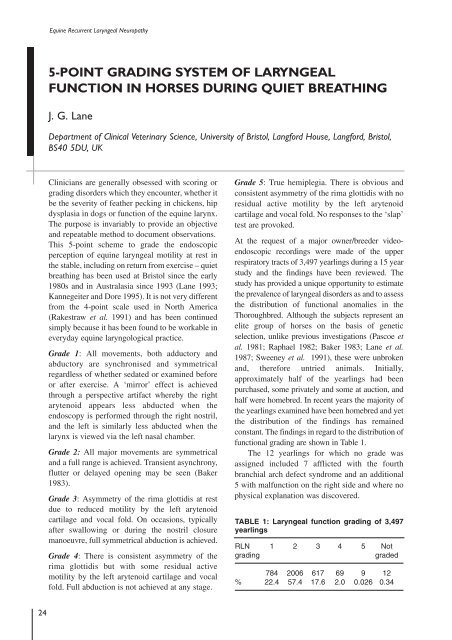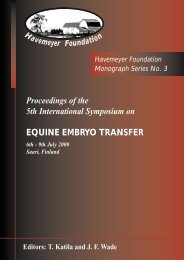Proceedings of a Workshop on - The Havemeyer Foundation
Proceedings of a Workshop on - The Havemeyer Foundation
Proceedings of a Workshop on - The Havemeyer Foundation
Create successful ePaper yourself
Turn your PDF publications into a flip-book with our unique Google optimized e-Paper software.
Equine Recurrent Laryngeal Neuropathy<br />
5-POINT GRADING SYSTEM OF LARYNGEAL<br />
FUNCTION IN HORSES DURING QUIET BREATHING<br />
J. G. Lane<br />
Department <str<strong>on</strong>g>of</str<strong>on</strong>g> Clinical Veterinary Science, University <str<strong>on</strong>g>of</str<strong>on</strong>g> Bristol, Langford House, Langford, Bristol,<br />
BS40 5DU, UK<br />
Clinicians are generally obsessed with scoring or<br />
grading disorders which they encounter, whether it<br />
be the severity <str<strong>on</strong>g>of</str<strong>on</strong>g> feather pecking in chickens, hip<br />
dysplasia in dogs or functi<strong>on</strong> <str<strong>on</strong>g>of</str<strong>on</strong>g> the equine larynx.<br />
<strong>The</strong> purpose is invariably to provide an objective<br />
and repeatable method to document observati<strong>on</strong>s.<br />
This 5-point scheme to grade the endoscopic<br />
percepti<strong>on</strong> <str<strong>on</strong>g>of</str<strong>on</strong>g> equine laryngeal motility at rest in<br />
the stable, including <strong>on</strong> return from exercise – quiet<br />
breathing has been used at Bristol since the early<br />
1980s and in Australasia since 1993 (Lane 1993;<br />
Kannegeiter and Dore 1995). It is not very different<br />
from the 4-point scale used in North America<br />
(Rakestraw et al. 1991) and has been c<strong>on</strong>tinued<br />
simply because it has been found to be workable in<br />
everyday equine laryngological practice.<br />
Grade 1: All movements, both adductory and<br />
abductory are synchr<strong>on</strong>ised and symmetrical<br />
regardless <str<strong>on</strong>g>of</str<strong>on</strong>g> whether sedated or examined before<br />
or after exercise. A ‘mirror’ effect is achieved<br />
through a perspective artifact whereby the right<br />
arytenoid appears less abducted when the<br />
endoscopy is performed through the right nostril,<br />
and the left is similarly less abducted when the<br />
larynx is viewed via the left nasal chamber.<br />
Grade 2: All major movements are symmetrical<br />
and a full range is achieved. Transient asynchr<strong>on</strong>y,<br />
flutter or delayed opening may be seen (Baker<br />
1983).<br />
Grade 3: Asymmetry <str<strong>on</strong>g>of</str<strong>on</strong>g> the rima glottidis at rest<br />
due to reduced motility by the left arytenoid<br />
cartilage and vocal fold. On occasi<strong>on</strong>s, typically<br />
after swallowing or during the nostril closure<br />
manoeuvre, full symmetrical abducti<strong>on</strong> is achieved.<br />
Grade 4: <strong>The</strong>re is c<strong>on</strong>sistent asymmetry <str<strong>on</strong>g>of</str<strong>on</strong>g> the<br />
rima glottidis but with some residual active<br />
motility by the left arytenoid cartilage and vocal<br />
fold. Full abducti<strong>on</strong> is not achieved at any stage.<br />
Grade 5: True hemiplegia. <strong>The</strong>re is obvious and<br />
c<strong>on</strong>sistent asymmetry <str<strong>on</strong>g>of</str<strong>on</strong>g> the rima glottidis with no<br />
residual active motility by the left arytenoid<br />
cartilage and vocal fold. No resp<strong>on</strong>ses to the ‘slap’<br />
test are provoked.<br />
At the request <str<strong>on</strong>g>of</str<strong>on</strong>g> a major owner/breeder videoendoscopic<br />
recordings were made <str<strong>on</strong>g>of</str<strong>on</strong>g> the upper<br />
respiratory tracts <str<strong>on</strong>g>of</str<strong>on</strong>g> 3,497 yearlings during a 15 year<br />
study and the findings have been reviewed. <strong>The</strong><br />
study has provided a unique opportunity to estimate<br />
the prevalence <str<strong>on</strong>g>of</str<strong>on</strong>g> laryngeal disorders as and to assess<br />
the distributi<strong>on</strong> <str<strong>on</strong>g>of</str<strong>on</strong>g> functi<strong>on</strong>al anomalies in the<br />
Thoroughbred. Although the subjects represent an<br />
elite group <str<strong>on</strong>g>of</str<strong>on</strong>g> horses <strong>on</strong> the basis <str<strong>on</strong>g>of</str<strong>on</strong>g> genetic<br />
selecti<strong>on</strong>, unlike previous investigati<strong>on</strong>s (Pascoe et<br />
al. 1981; Raphael 1982; Baker 1983; Lane et al.<br />
1987; Sweeney et al. 1991), these were unbroken<br />
and, therefore untried animals. Initially,<br />
approximately half <str<strong>on</strong>g>of</str<strong>on</strong>g> the yearlings had been<br />
purchased, some privately and some at aucti<strong>on</strong>, and<br />
half were homebred. In recent years the majority <str<strong>on</strong>g>of</str<strong>on</strong>g><br />
the yearlings examined have been homebred and yet<br />
the distributi<strong>on</strong> <str<strong>on</strong>g>of</str<strong>on</strong>g> the findings has remained<br />
c<strong>on</strong>stant. <strong>The</strong> findings in regard to the distributi<strong>on</strong> <str<strong>on</strong>g>of</str<strong>on</strong>g><br />
functi<strong>on</strong>al grading are shown in Table 1.<br />
<strong>The</strong> 12 yearlings for which no grade was<br />
assigned included 7 afflicted with the fourth<br />
branchial arch defect syndrome and an additi<strong>on</strong>al<br />
5 with malfuncti<strong>on</strong> <strong>on</strong> the right side and where no<br />
physical explanati<strong>on</strong> was discovered.<br />
TABLE 1: Laryngeal functi<strong>on</strong> grading <str<strong>on</strong>g>of</str<strong>on</strong>g> 3,497<br />
yearlings<br />
RLN 1 2 3 4 5 Not<br />
grading<br />
graded<br />
784 2006 617 69 9 12<br />
% 22.4 57.4 17.6 2.0 0.026 0.34<br />
24








